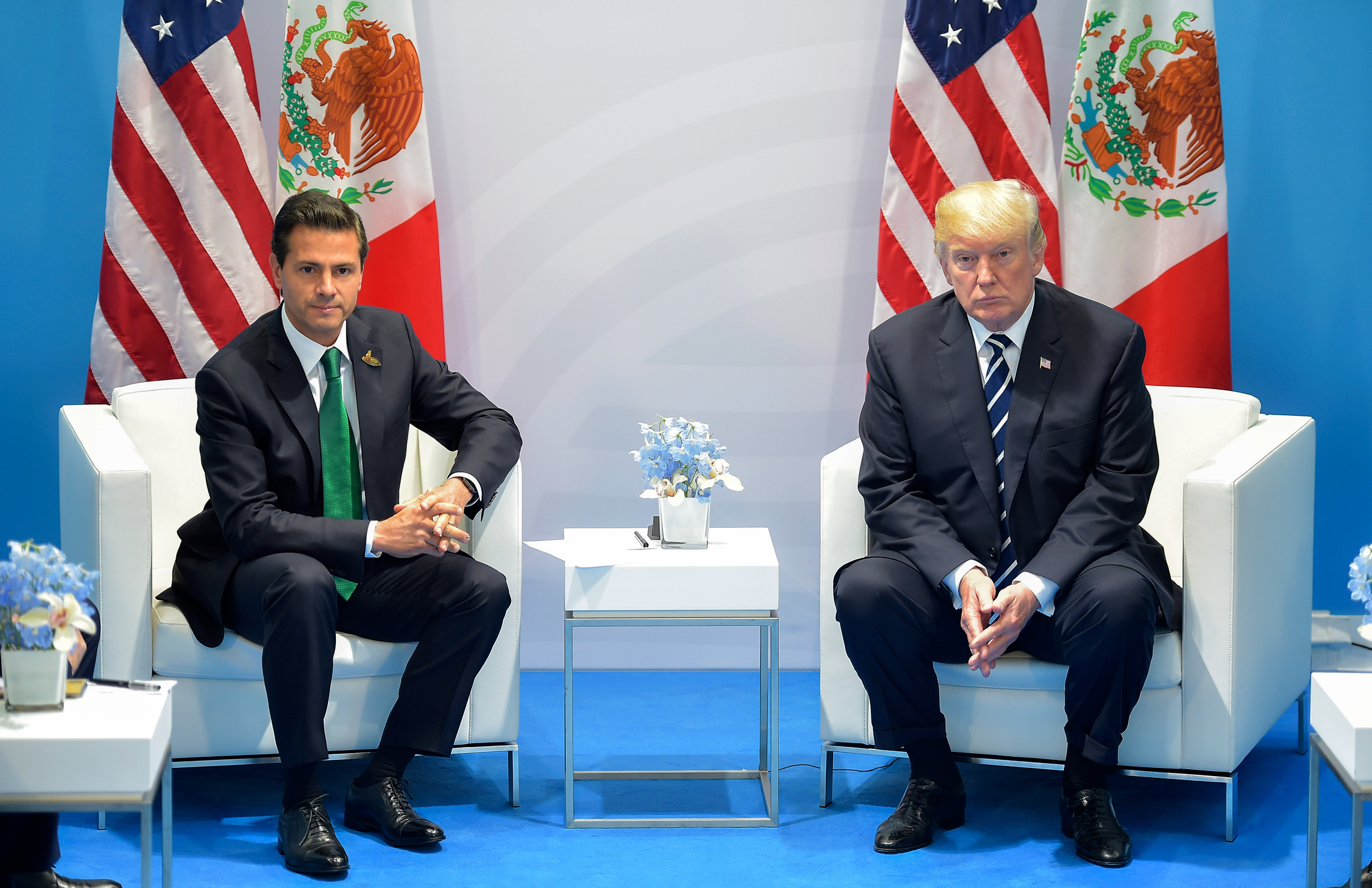
Mexican President Enrique Pena Nieto and Donald Trump
Early in February 2018, U.S. Secretary of State Rex Tillerson travelled to Latin America, signaling America’s renewed interest in its proverbial “backyard.” Mr. Tillerson’s visits to Mexico, Colombia, Peru, and Argentina were welcomed by governments that have either avoided or recently reversed the “pink tide” of populist and anti-American regimes that took power in the hemisphere in the last decade. Tillerson’s tour, however, reflects the Trump administration’s interest in addressing a number of critical regional challenges which have gone largely ignored for more than a decade and which could potentially create serious obstacles to U.S. foreign policy in the region.
Overshadowing the visit were the words of President Donald J. Trump, which have been met with consternation throughout the hemisphere. Mr. Trump’s language, if not his actual policies, have riled many who believe his calls for a wall and protectionist tariffs between the U.S. and Mexico are a metaphor for closing the door on a traditional relationship with Latin America and the Caribbean. In this context, Mr. Tillerson had his work cut out for him.
Mr. Tillerson’s visit is notable for two reasons. The first is the upcoming election in Mexico which, contrary to the prevailing winds, may place a hostile, anti-U.S. demagogue at the head of the U.S.’s largest trade partner south of the border. The second, more long-term issue is the growing presence and influence of the People’s Republic of China (PRC) in the hemisphere via economic opportunities. A President López Obrador may take a page from the populist playbook by opening a wider door to China as a counterweight to the U.S. in Mexico and raising tensions further.
The AMLO Factor
The upcoming elections in Mexico have become a source of concern throughout the region. When Mexicans go to the polls on July 1, 2018, their choices will not only have consequences for U.S.-Mexico relations, but for U.S.-China relations as well. The front-runner, former Mexico City mayor Andrés Manuel López Obrador (known as AMLO), is an admirer of the Cuban and Venezuelan revolutions with a long history of demonstrated support for other leftist and populist causes. His previous campaigns for the presidency failed due to allegations of fraud and corruption by the governing Institutional Revolutionary Party (PRI).
In the 2012 presidential election, AMLO received 32.6 percent of the vote against the PRI’s Enrique Peña Nieto, who received 38 percent. This year, opinion polls show AMLO due to receive 34 percent of the anticipated votes, giving him an 11 percent lead over the right-center “For Mexico in Front” coalition candidate Ricardo Anaya. The PRI candidate, José Antonio Meade, is behind with 16 percent of the votes. These projections are important because Mexican law declares the candidate with a plurality of votes as the winner. Unlike some countries, in which the two top candidates advance to a run-off to win at least 51 percent, Mexico has only one voting phase, and a candidate may rule the country even with a minority of the vote. To date, AMLO is within striking distance of a victory.
Mr. López Obrador has already raised eyebrows in financial circles by pledging to roll back Peña Nieto’s reforms that opened the Mexican petroleum industry to foreign investors. AMLO recently declared: “We will revise all these contracts, we will not allow the oil, which is owned by the people and the nation, to go back into the hands of foreigners.”
Though he has recently toned down his more radical pronouncements to broaden his appeal, AMLO has previously called for ending cooperation with the U.S. Drug Enforcement Agency and the CIA, including the use of unmanned drones and shared intelligence operations. These declarations have heightened concerns among Mexican and U.S. national security analysts.
President Trump’s war of words with Mexican leaders has encouraged nationalist and populist rhetoric in Mexico City, giving López Obrador plenty of ammunition to fashion his campaign as a rallying point for long-standing anti-U.S. sentiment. Cuba and Venezuela are also betting on an AMLO victory to provide cover and a respite for their ailing regimes.
The U.S. State Department seems concerned that Mexico may “go pink” with the election of AMLO. The recent appointment of Kim Breier, a Mexico specialist, as the assistant secretary of state for western hemisphere affairs is one indication of renewed attention to the country by foreign policy decision makers. No doubt, Tillerson’s visit to Mexico included a list of scenarios and options concerning an AMLO victory. For some in the region, López Obrador’s election would be like lighting a match in a room full of gasoline.
Enter China
The deteriorating relationship between Mexico City and Washington also comes on the heels of increasing Chinese trade and investments in Mexico. Even before tensions rose between the U.S. and Mexico, a report by the Atlantic Council on Chinese foreign direct investment in the Americas cited a significant increase in the PRC’s business with Mexico. The country has seen more than forty deals valued at over $4 billion in the span of three years (2014-2016) from China – a remarkable amount considering no previous year had seen more than five deals. Many of these deals are in the automotive, IT, and alternative energy industries.
As the prospects of a renegotiated North American Free Trade Agreement (NAFTA) and a protectionist war on Mexican exports to the U.S. loom larger under the Trump administration, it makes sense that some of Mexico’s industries might consider diversifying their investment partnerships and markets.
For China, its new interest in Mexico reflects a shift in investment away from traditional extractive industries (oil, gas, copper, iron ore) and towards the service sector (IT, financial services, and infrastructure and energy). For the fifth year running, the Grupo de Alto Nivel Empresarial Mexico-China (Mexico-China High Level Business Group), an association of twenty-five Mexican and Chinese companies, has met to consider greater cooperation between financial and energy industries as China becomes Mexico’s second largest trading partner. The group has become the central meeting point for Chinese tech companies such as Huawei and Mexican airline Aeroméxico. Such efforts are promoted by the current PRI administration, but could take on greater importance under an AMLO government.
The numbers show that China’s new focus on Mexico has grown apace, despite the primacy of U.S.-Mexico economic relations. For example, according to an article in Politico, China is now Mexico’s third-largest export partner, receiving $5 billion in goods in 2016. Mexico also imports almost 20 percent — roughly $70 billion — of its goods from China. China is Mexico’s second-largest import partner, according to the World Integrated Trade Solution. Still, U.S. trade with Mexico is upward of $600 billion, overshadowing any other country, and the U.S. absorbs 80 percent of Mexican exports; almost half of Mexico’s imports come from the U.S.
Once seen as competitors for U.S. customers and markets, Mexico and China now appear to be recalculating their relationship. American markets dominate the Mexican economy and will continue to do so for many decades, but the combination of China’s growing presence in Mexico and the election of a leftist firebrand to the Mexican presidency could further strain U.S. relationships with both of these countries. Chances are this visit will not be Mr. Tillerson’s last trip south of the border.

